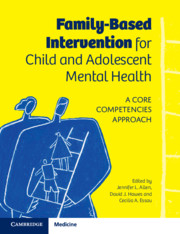Book contents
- Family-Based Intervention for Child and Adolescent Mental Health
- Family-Based Intervention for Child and Adolescent Mental Health
- Copyright page
- Contents
- Contributors
- Preface
- Part I Theoretical Perspectives on Family-Based Intervention
- Part II Core Clinical Competencies
- Part III Family Intervention for Specific Child and Adolescent Mental Health Problems
- Part IV Family Intervention for Children at Risk Due to Family Dysfunction or Past Adversity
- Chapter 16 Working with Parents with Depression in Family Intervention
- Chapter 17 Working with Parents with Anxiety in Family Intervention
- Chapter 18 Working with Families of Children Who Have Experienced Maltreatment
- Chapter 19 Working with Families and Children Exposed to Intimate Partner Violence
- Part V New Developments in Family-Based Intervention
- Index
- References
Chapter 17 - Working with Parents with Anxiety in Family Intervention
from Part IV - Family Intervention for Children at Risk Due to Family Dysfunction or Past Adversity
Published online by Cambridge University Press: 18 February 2021
- Family-Based Intervention for Child and Adolescent Mental Health
- Family-Based Intervention for Child and Adolescent Mental Health
- Copyright page
- Contents
- Contributors
- Preface
- Part I Theoretical Perspectives on Family-Based Intervention
- Part II Core Clinical Competencies
- Part III Family Intervention for Specific Child and Adolescent Mental Health Problems
- Part IV Family Intervention for Children at Risk Due to Family Dysfunction or Past Adversity
- Chapter 16 Working with Parents with Depression in Family Intervention
- Chapter 17 Working with Parents with Anxiety in Family Intervention
- Chapter 18 Working with Families of Children Who Have Experienced Maltreatment
- Chapter 19 Working with Families and Children Exposed to Intimate Partner Violence
- Part V New Developments in Family-Based Intervention
- Index
- References
Summary
Parental anxiety and anxiety disorders (ADs) are increasingly recognized as a risk factor in the development of childhood disorders. In this chapter, we first examine the impact parental anxiety and ADs have on youth outcomes, with a focus on the inter-generational transmission of ADs through mechanisms such as parental control and negativity. Next, we explore the role these negative parenting behaviours play in the treatment of specific childhood disorders. Family cognitive behavioural therapy (CBT) for ADs and obsessive compulsive disorder (OCD) is reviewed in its current forms to highlight innovations and barriers in family-based interventions broadly and treatment of parental anxiety and ADs specifically. Lastly, we provide research and clinical recommendations to promote more effective treatment of childhood disorders in the context of complex family systems.
Keywords
- Type
- Chapter
- Information
- Family-Based Intervention for Child and Adolescent Mental HealthA Core Competencies Approach, pp. 225 - 241Publisher: Cambridge University PressPrint publication year: 2021



